Catalysts in Chemistry: Types, Functions, and Applications
What is a Catalyst?
A catalyst is a substance that increases the rate of a chemical reaction without itself being consumed or permanently altered in the process. Catalysts work by providing an alternative reaction pathway with a lower activation energy than the uncatalyzed reaction.
Types of Catalysts
Catalysts can be classified into several categories based on their nature, phase, and mode of action. Below is a detailed classification:
1. Based on Phase (Homogeneous vs. Heterogeneous)
A. Homogeneous Catalysts
- Same phase as reactants (usually liquid or gas).
- Mechanism: Forms intermediate complexes with reactants.
- Advantages: High selectivity, uniform active sites.
- Disadvantages: Difficult separation, often sensitive to conditions.
Examples:
- Acid/Base Catalysts:
- H₂SO₄ (esterification), NaOH (saponification).
- Organometallic Catalysts:
- Wilkinson’s catalyst [(Ph₃P)₃RhCl] for hydrogenation.
- Enzymes in Solution:
- Amylase in starch hydrolysis.
B. Heterogeneous Catalysts
- Different phase from reactants (usually solid with gas/liquid reactants).
- Mechanism: Reactants adsorb on the catalyst surface, react, then desorb.
- Advantages: Easy separation, reusable, thermally stable.
- Disadvantages: Diffusion limitations, surface poisoning.
Examples:
- Metal Catalysts:
- Pt/Pd/Rh (catalytic converters), Ni (hydrogenation).
- Metal Oxides:
- V₂O₅ (Contact process for H₂SO₄), TiO₂ (photocatalysis).
- Zeolites:
- ZSM-5 (petroleum cracking).
2. Based on Composition
A. Inorganic Catalysts
- Metals:
- Pt, Pd, Ni (hydrogenation, fuel cells).
- Metal Oxides:
- Al₂O₃ (dehydration), Cr₂O₃ (polymerization).
- Acids/Bases:
- H₃PO₄, KOH (industrial synthesis).
B. Organic Catalysts (Organocatalysts)
- Metal-free small organic molecules.
- Examples:
- Proline (asymmetric synthesis), DMAP (acylations).
C. Biological Catalysts (Enzymes)
- Protein-based, highly specific.
- Examples:
- Lipase (fat breakdown), DNA polymerase (PCR).
3. Based on Function
A. Positive Catalysts
- Increase reaction rate (most common type).
- Example: MnO₂ speeds up H₂O₂ decomposition.
B. Negative Catalysts (Inhibitors)
- Decrease reaction rate (used to prevent unwanted reactions).
- Example: Lead tetraethyl in gasoline (reduces engine knocking).
C. Auto-Catalysts
- One product acts as a catalyst for its own formation.
- Example:
- In permanganate titration, Mn²⁺ autocatalyzes the reaction.
4. Specialized Catalysts
A. Photocatalysts
- Activated by light (UV/visible).
- Examples:
- TiO₂ (water purification), chlorophyll (photosynthesis).
B. Electrocatalysts
- Facilitate redox reactions in fuel cells/batteries.
- Examples:
- Pt/C (H₂ oxidation), IrO₂ (oxygen evolution reaction).
C. Nanocatalysts
- Nanoparticles with high surface area.
- Examples:
- Au NPs (CO oxidation), Fe₃O₄ NPs (organic synthesis).
D. Chiral Catalysts
- Produce enantiopure compounds (important in pharma).
- Examples:
- BINAP-Ru (synthesizing L-DOPA).
5. Industrial vs. Biological Catalysts
| Feature | Industrial Catalysts | Biological Catalysts (Enzymes) |
|---|---|---|
| Composition | Metals, metal oxides, zeolites | Proteins (some RNAs) |
| Conditions | High T/P, harsh chemicals | Mild (physiological) |
| Specificity | Moderate | Extremely high |
| Examples | Fe (Haber process), Pt (cars) | Amylase, DNA polymerase |
Catalyst-Driven Reactions: Mechanisms and Examples
Catalysts accelerate chemical reactions through distinct mechanisms while remaining unchanged. Here’s a comprehensive breakdown:
1. Core Principles of Catalyzed Reactions
- Activation Energy Reduction: Provides alternative pathway with lower Eₐ
- Selective Transition State Stabilization: Stabilizes high-energy intermediates
- Regeneration: Catalyst returns to original state after reaction
- No Equilibrium Shift: Affects only reaction rate, not position of equilibrium
2. Reaction Mechanisms
A. Heterogeneous Catalysis (Surface Reactions)
Steps:
- Adsorption: Reactants bind to active sites (e.g., H₂ on Pt surface)
- Surface Migration: Reactants diffuse across catalyst
- Reaction: Bond breaking/formation (e.g., CO + O → CO₂ on Pd)
- Desorption: Products release from surface
Example:
Catalytic Converter Reaction
2CO + 2NO → (Pt/Pd/Rh) → 2CO₂ + N₂
B. Homogeneous Catalysis (Solution-Phase)
Mechanisms:
- Coordination Complex Formation:
e.g., Wilkinson’s catalyst [(Ph₃P)₃RhCl] hydrogenating alkenes via Rh-H intermediate - Acid-Base Catalysis:
e.g., H⁺ catalyzing ester hydrolysis through protonated intermediate
Example:
Olefin Metathesis (Nobel Prize 2005)
Grubbs’ catalyst (Ru-based) swaps alkylidene groups between alkenes
C. Enzymatic Catalysis
Models:
- Lock-and-Key: Precise substrate fit (e.g., glucose in hexokinase)
- Induced Fit: Active site conformational change
Example:
Carbonic Anhydrase
CO₂ + H₂O → (Zn²⁺ active site) → HCO₃⁻ + H⁺ (10⁷x faster than uncatalyzed)
3. Thermodynamics vs. Kinetics
| Aspect | Uncatalyzed Reaction | Catalyzed Reaction |
|---|---|---|
| ΔG | Unchanged | Unchanged |
| Eₐ | Higher | Lower |
| Rate | Slower | Faster |
| Mechanism | Direct pathway | Multi-step pathway |
4. Industrial Reaction Examples
a. Haber Process (NH₃ Synthesis)
N₂ + 3H₂ → (Fe/K₂O catalyst, 400-500°C) → 2NH₃
Mechanism: N₂ dissociation on Fe surface (rate-limiting step)
b. FCC (Fluid Catalytic Cracking)
C₄₀H₈₂ → (Zeolite Y catalyst) → Gasoline-range hydrocarbons
Mechanism: Carbocation formation in zeolite pores
c. Asymmetric Hydrogenation
Acetophenone → (BINAP-Ru catalyst) → (R)-1-phenylethanol
Mechanism: Chiral environment controls H₂ addition
5. Catalyst Deactivation Pathways
- Poisoning: Strong adsorption of impurities (e.g., S on Pt)
- Coking: Carbon deposition (common in petroleum refining)
- Sintering: Particle aggregation at high temperatures
- Leaching: Loss of active species (homogeneous systems)
6. Emerging Catalytic Technologies
- Single-Atom Catalysts: Maximized atom efficiency (e.g., Pt₁/FeOx for CO oxidation)
- Biomimetic Catalysis: Synthetic enzymes for C-H activation
- Plasma Catalysis: Synergistic effects with non-thermal plasma
7. Quantitative Analysis
- Turnover Frequency (TOF): Molecules converted per active site per second
- Selectivity: % desired product vs. byproducts
Example: Ziegler-Natta catalysts achieve >99% isotactic polypropylene
Applications of Catalysts
Catalysts play a crucial role in various industries, environmental protection, and biological processes. Below are the key applications of catalysts in different fields:
1. Industrial Applications
A. Petroleum Refining & Petrochemicals
- Catalytic Cracking: Zeolites (e.g., ZSM-5) break heavy hydrocarbons into gasoline, diesel, and other fuels.
- Hydroprocessing: Nickel, platinum, or palladium catalysts remove sulfur (hydrodesulfurization) and nitrogen from fuels.
- Reforming: Platinum-rhenium catalysts convert low-octane hydrocarbons into high-octane gasoline.
B. Chemical Manufacturing
- Haber-Bosch Process: Iron-based catalysts produce ammonia (NH₃) from nitrogen and hydrogen (for fertilizers).
- Contact Process: Vanadium pentoxide (V₂O₅) converts sulfur dioxide (SO₂) to sulfur trioxide (SO₃) for sulfuric acid (H₂SO₄) production.
- Methanol Synthesis: Copper-zinc oxide (Cu/ZnO) catalysts convert CO/CO₂ + H₂ into methanol.
- Polymerization: Ziegler-Natta catalysts (TiCl₄ + Al alkyls) produce polyethylene and polypropylene.
C. Pharmaceutical & Fine Chemicals
- Asymmetric Catalysis: Chiral catalysts (e.g., BINAP-Ru) produce enantiopure drugs (e.g., L-DOPA for Parkinson’s disease).
- Hydrogenation: Palladium on carbon (Pd/C) reduces nitro groups to amines in drug synthesis.
2. Environmental Applications
A. Automotive Catalytic Converters
- Three-Way Catalysts (Pt, Pd, Rh) convert harmful exhaust gases:
- CO → CO₂
- NOx → N₂ + O₂
- Unburned hydrocarbons → CO₂ + H₂O
B. Industrial Emission Control
- Selective Catalytic Reduction (SCR): Vanadium-tungsten-titanium (V₂O₅-WO₃/TiO₂) catalysts reduce NOx emissions from power plants using NH₃.
- Volatile Organic Compound (VOC) Abatement: Platinum or manganese oxide catalysts oxidize VOCs into CO₂ and H₂O.
C. Water & Air Purification
- Photocatalysis: Titanium dioxide (TiO₂) under UV light degrades organic pollutants in water and air.
- Ozone Decomposition: Manganese dioxide (MnO₂) catalysts break down ozone (O₃) in aircraft cabins and industrial settings.
3. Energy Production & Storage
A. Fuel Cells
- Proton Exchange Membrane (PEM) Fuel Cells: Platinum (Pt) catalysts facilitate hydrogen oxidation and oxygen reduction.
- Solid Oxide Fuel Cells (SOFCs): Nickel-yttria-stabilized zirconia (Ni-YSZ) anodes convert hydrogen into electricity.
B. Hydrogen Production
- Steam Reforming: Nickel catalysts convert methane (CH₄) + H₂O → H₂ + CO (for hydrogen fuel).
- Water Splitting (Electrolysis): Iridium/ruthenium oxide (IrO₂/RuO₂) catalysts enhance oxygen evolution (OER).
C. Biofuel Production
- Transesterification: Sodium hydroxide (NaOH) or lipase enzymes convert vegetable oils into biodiesel.
- Fischer-Tropsch Synthesis: Cobalt/iron catalysts convert syngas (CO + H₂) into liquid fuels.
4. Biological & Food Industry Applications
A. Enzymes in Biotechnology
- Amylase: Breaks starch into sugars (beer, bread production).
- Protease: Used in detergents (breaks protein stains).
- DNA Polymerase: Essential for PCR (genetic testing).
B. Food Processing
- Glucose Isomerase: Converts glucose to fructose (high-fructose corn syrup).
- Lipase: Enhances cheese flavor by breaking down fats.
5. Emerging & Future Applications
- Single-Atom Catalysts (SACs): Maximize efficiency in CO₂ conversion.
- Artificial Photosynthesis: Cobalt-based catalysts mimic plant photosynthesis for fuel production.
- Plastic Recycling: Catalysts break down PET plastics into reusable monomers.
Principles of Catalysis
Catalysis is governed by fundamental chemical principles that explain how catalysts accelerate reactions without being consumed. Below are the key principles:
1. Lowering Activation Energy (Eₐ)
- Catalysts provide an alternative reaction pathway with a lower activation energy barrier than the uncatalyzed reaction.
- This allows more reactant molecules to have sufficient energy to react at a given temperature.
- Example: The decomposition of H₂O₂ is slow, but adding MnO₂ (a catalyst) speeds it up by reducing Eₐ.
2. Formation of Transition States or Intermediates
- Catalysts temporarily bind to reactants, forming transition-state complexes or intermediates.
- These intermediates are more stable than the uncatalyzed transition state, lowering Eₐ.
- Example: In enzyme catalysis (lock-and-key model), the substrate binds to the active site, forming an enzyme-substrate complex.
3. No Effect on Equilibrium
- Catalysts do not change the position of chemical equilibrium (ΔG remains the same).
- They only speed up the attainment of equilibrium by accelerating both forward and reverse reactions equally.
- Example: In the Haber process (N₂ + 3H₂ ⇌ 2NH₃), Fe catalyst speeds up both NH₃ formation and decomposition.
4. Catalyst Regeneration
- A true catalyst is not consumed in the reaction and is regenerated at the end.
- Example: In catalytic converters, Pt/Pd/Rh convert CO → CO₂ and NO → N₂, then return to their original state.
5. Surface Area Matters (Heterogeneous Catalysis)
- For solid catalysts (e.g., Pt in hydrogenation), high surface area increases active sites for reactant adsorption.
- Example: Porous materials like zeolites or activated metals (e.g., Raney nickel) enhance catalytic activity.
6. Specificity & Selectivity
- Catalysts often favor certain reactions over others:
- Chemoselectivity: Prefers one functional group (e.g., hydrogenating C=C over C=O).
- Stereoselectivity: Produces specific stereoisomers (e.g., chiral catalysts in drug synthesis).
- Example: Enzymes like lactase only break down lactose, not other sugars.
7. Mechanisms of Catalysis
A. Homogeneous Catalysis
- Catalyst and reactants are in the same phase (usually liquid).
- Example: Sulfuric acid (H₂SO₄) catalyzes esterification (organic synthesis).
B. Heterogeneous Catalysis
- Catalyst is in a different phase (usually solid with gas/liquid reactants).
- Steps:
- Adsorption: Reactants bind to the catalyst surface.
- Reaction: Bonds break/form on the surface.
- Desorption: Products leave the surface.
- Example: Pt in catalytic converters.
C. Enzyme Catalysis
- Follows Michaelis-Menten kinetics:
- Substrate (S) binds to enzyme (E) → ES complex → Product (P) + E.
- Example: Carbonic anhydrase speeds up CO₂ hydration in blood.
D. Acid-Base Catalysis
- General acid catalysis: Proton (H⁺) donation (e.g., HCl in hydrolysis).
- General base catalysis: Proton (H⁺) acceptance (e.g., OH⁻ in saponification).
8. Promoters & Inhibitors
- Promoters enhance catalyst activity (e.g., K₂O in Fe Haber catalysts).
- Inhibitors/Poisons deactivate catalysts (e.g., Sulfur poisons Pt in fuel cells).
-
All About Vitamins Functions, Sources, Deficiencies And Sample Questions
What is Vitamin Vitamins are organic compounds required in small amounts for essential metabolic processes in the body. They are not synthesized in sufficient quantities by the body (except Vitamin D in some cases) and must be obtained through the diet. Vitamins are classified into two categories based on solubility Fat Soluble Vitamins are A…
-
How to Determine Normality of Sodium Thiosulfate
Appratous Volumetric flask Burette Pipette Conical flask (Erlenmeyer flask) Beaker Measuring cylinder Stirring rod Funnel Dropper White tile (for better visibility during titration) Wash bottle (for distilled water) Normality of Sodium Thiosulfate 10 ml K₂Cr₂O₇ 25 ml water. 5 ml conc. HCl KI 10% 20 ml. 5 minutes shake in dark Room place 20 minutes.…
-
Preparation of 4% Neutral Boric Acid Solution
Required Apparatus One-liter beaker Stirring rod Hot plate or heat source Measuring cylinder (for 750 mL water, 10 mL bromocresol green, and 7 mL methyl red) One-liter reagent stoppered boqttle Pipette or dropper (for precise liquid measurements) Balance or scale (for measuring 40 gm boric acid) Distilled water container Preparation of 4% Neutral Boric Acid…

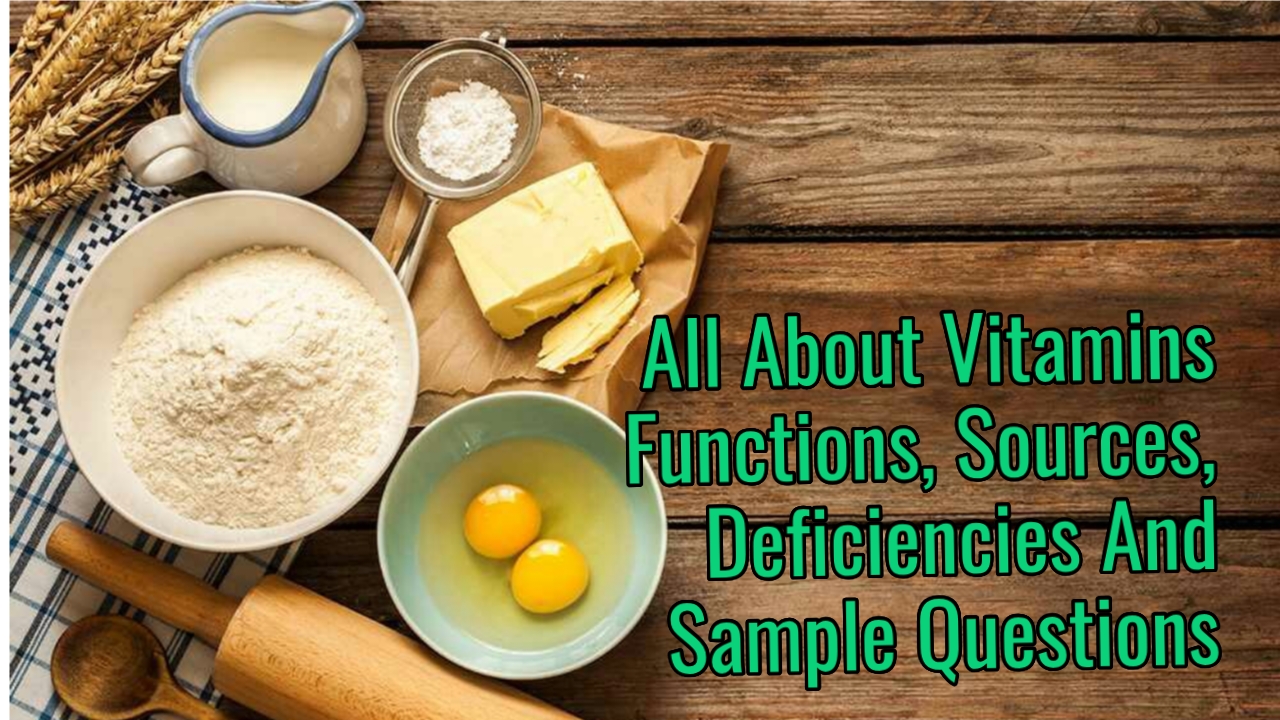
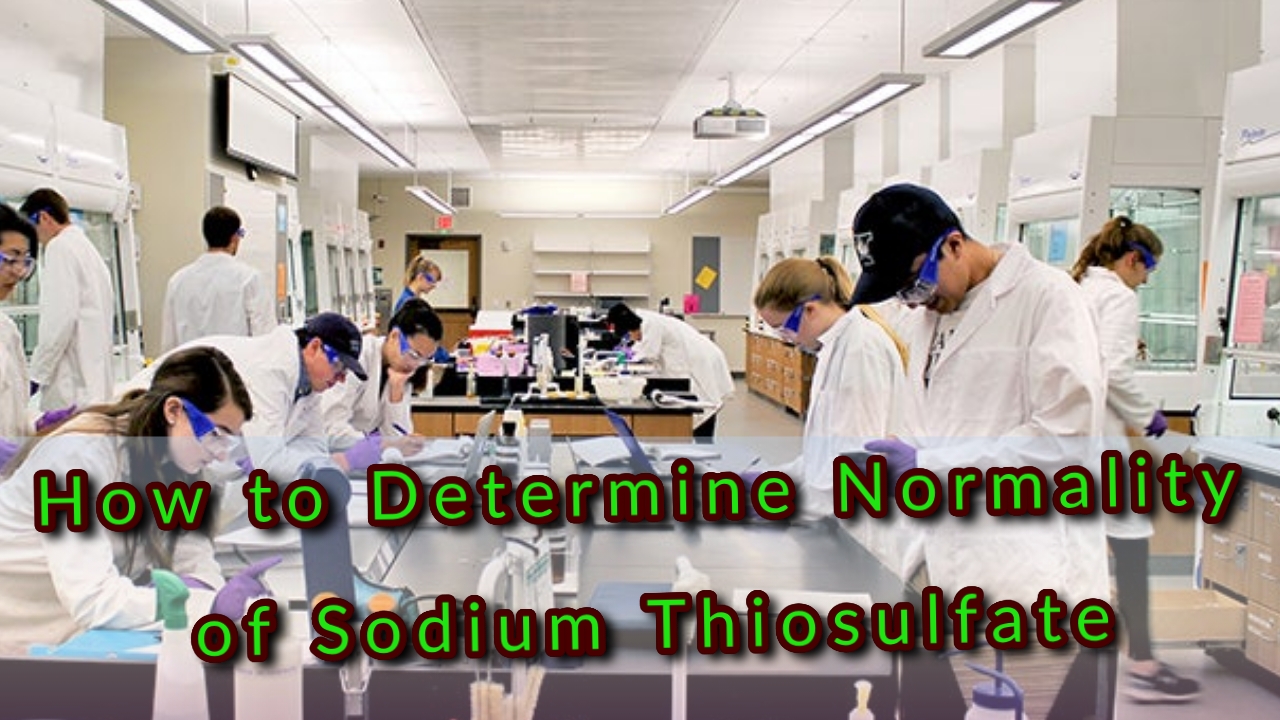
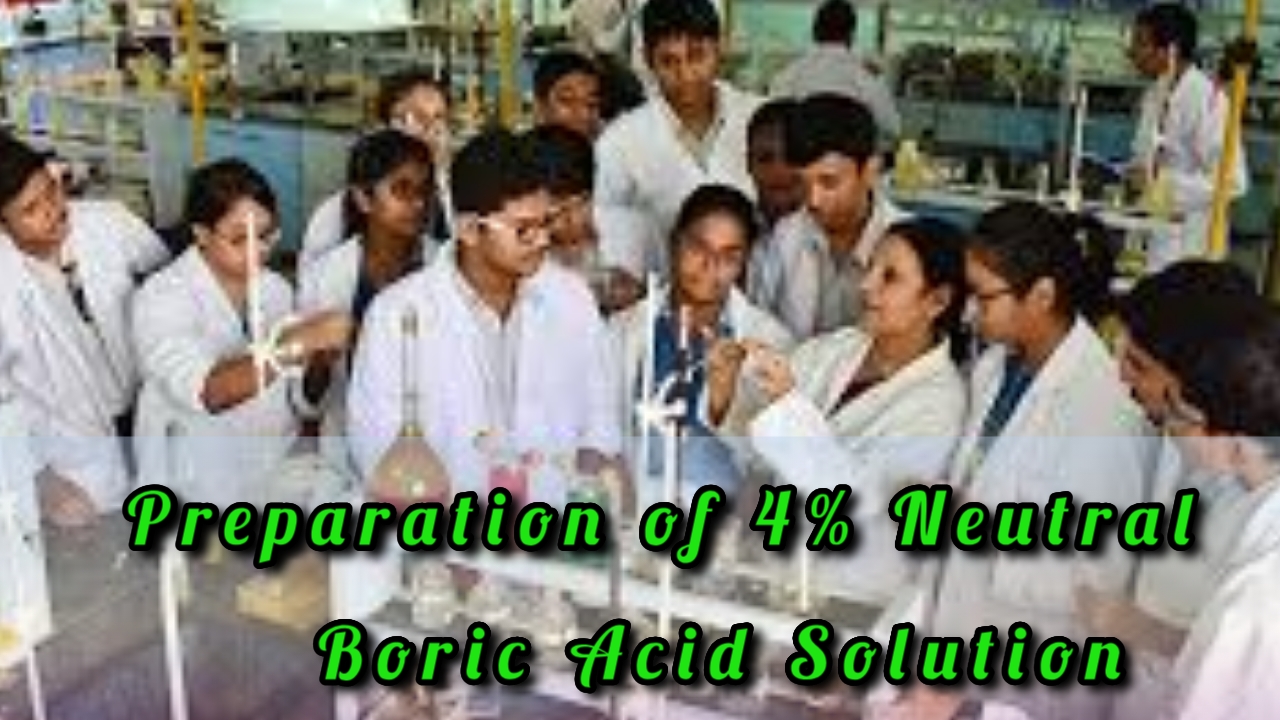
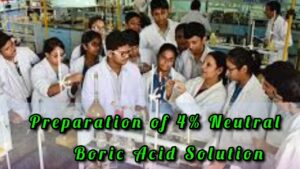


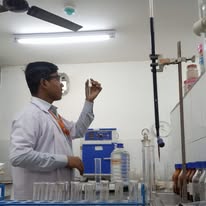
Post Comment